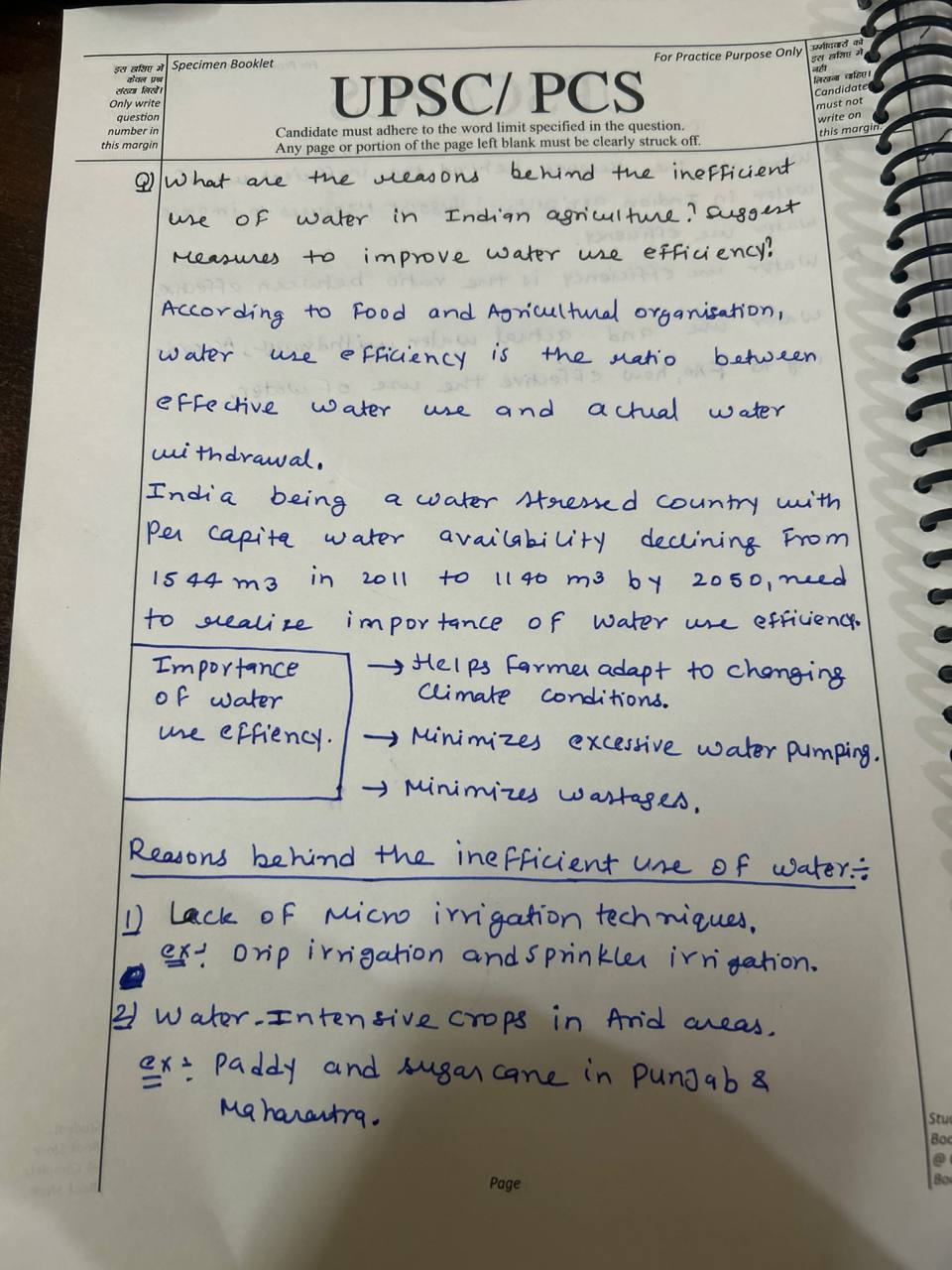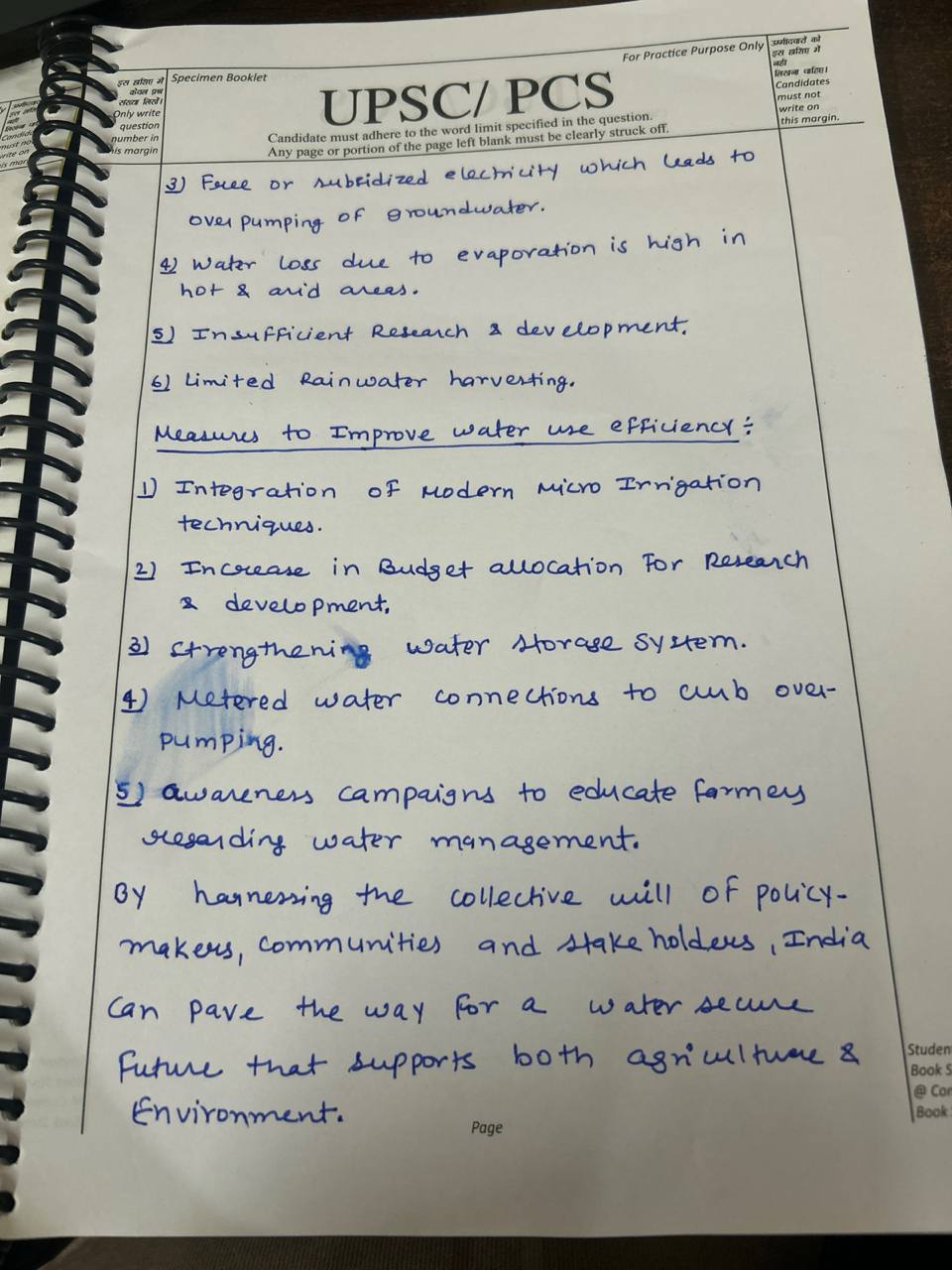Roadmap for Answer Writing 1. Introduction Define Irrigation: Start by explaining the importance of irrigation in agriculture, especially in India where a large portion of agriculture is dependent on monsoon rains. Contextualize Irrigation in India: Mention how irrigation impacts crop yield, food security, ...
Model Answer Introduction Water scarcity is a pressing issue in India, where the country has 18% of the world's population but only 4% of its freshwater resources. Agriculture is the largest consumer of this limited water supply, emphasizing the need for efficient irrigation methods. Micro-irrigatioRead more
Model Answer
Introduction
Water scarcity is a pressing issue in India, where the country has 18% of the world’s population but only 4% of its freshwater resources. Agriculture is the largest consumer of this limited water supply, emphasizing the need for efficient irrigation methods. Micro-irrigation, which includes techniques like drip and sprinkler irrigation, offers a promising solution to this challenge.
Body
Benefits of Micro-Irrigation
- Reduction in Water Consumption
- Fact: Micro-irrigation can reduce agricultural water demand by 30-50% by delivering water directly to the root zone, minimizing losses through conveyance, runoff, and evaporation.
- Source: National Mission for Sustainable Agriculture.
- Decreased Dependence on Groundwater
- Fact: This method is particularly effective in dryland farming areas where groundwater aquifers are depleting. It significantly lowers electricity consumption, as less water needs to be pumped.
- Source: Ministry of Agriculture and Farmers’ Welfare.
- Sustainability
- Fact: Micro-irrigation can replace flood irrigation, which causes ecological issues like groundwater pollution and salinity. Localized application helps prevent nutrient leaching, preserving soil health.
- Source: Indian Council of Agricultural Research (ICAR).
- Scalability
- Fact: Currently, less than 50% of agricultural land is irrigated, with over 80% of farmers being smallholders. Micro-irrigation can reduce dependency on monsoons and enhance resilience against drought.
- Source: NABARD (National Bank for Agriculture and Rural Development).
Limitations of Micro-Irrigation
- Affordability Challenges
- The initial investment for micro-irrigation systems can be prohibitive for small and marginal farmers, limiting widespread adoption.
- Maintenance Costs
- Regular maintenance of tubes and sprinklers can be burdensome for small farmers, given the small size of their landholdings.
- Crop Choices
- Micro-irrigation may not alleviate water stress caused by poor agro-climatic choices, such as the cultivation of water-intensive crops like sugarcane and paddy in regions where water is already scarce.
Conclusion
Micro-irrigation has significant potential to alleviate India’s water crisis, especially in water-scarce regions. However, it should be part of a broader strategy that includes water conservation, improved water storage, and a shift in cropping patterns to maximize its effectiveness.
See less







Model Answer Introduction Irrigation refers to the artificial application of water to land to assist in the growth of crops. It is vital for ensuring consistent agricultural productivity in India, particularly in regions with erratic rainfall. In a country where agriculture is the backbone of the ecRead more
Model Answer
Introduction
Irrigation refers to the artificial application of water to land to assist in the growth of crops. It is vital for ensuring consistent agricultural productivity in India, particularly in regions with erratic rainfall. In a country where agriculture is the backbone of the economy, effective irrigation is essential for food security, improving crop yields, and boosting farmers’ incomes.
Irrigation Scenario of India:
Current Initiatives to Increase Irrigated Area:
- Pradhan Mantri Krishi Sinchayee Yojana (PMKSY): Launched in 2015, PMKSY aims to increase irrigation efficiency and expand the area under irrigation. Key components of this initiative include:
- Micro-irrigation (e.g., drip and sprinkler systems) to optimize water usage.
- Watershed development to enhance water storage and reduce wastage.
- The Per Drop More Crop component focuses on maximizing agricultural productivity with minimal water.
- Command Area Development (CAD) Program: This initiative aims to improve water use efficiency in areas under major and medium irrigation projects. By focusing on distribution and management, CAD helps farmers make better use of available water.
- Accelerated Irrigation Benefit Program (AIBP): AIBP focuses on completing stalled irrigation projects and improving water resource utilization. This program aims to ensure that irrigation systems are not just built but are functional and sustainable.
- Watershed Management and Rainwater Harvesting: Integrated watershed development programs (IWDP) aim to conserve water and increase its availability. By restoring degraded watersheds, these initiatives help improve water quality and availability for agriculture.
- Promotion of Micro-irrigation: The government encourages the use of drip and sprinkler irrigation systems through the PMKSY – Per Drop More Crop initiative. These systems help save water, improve crop yields, and reduce labor costs.
- Dams and Reservoirs: Large-scale irrigation projects like the Bhakra Nangal Dam, Hirakud Dam, and Sardar Sarovar Dam play a crucial role in storing water for agricultural use. As of 2021, 21 dam projects were under review for construction . These dams ensure a stable water supply for irrigation during dry periods.
- Technology and Innovation: The use of technologies like remote sensing and Geographic Information Systems (GIS) helps monitor water resources efficiently. This ensures better planning and management of irrigation systems, reducing wastage and improving water allocation.
See less